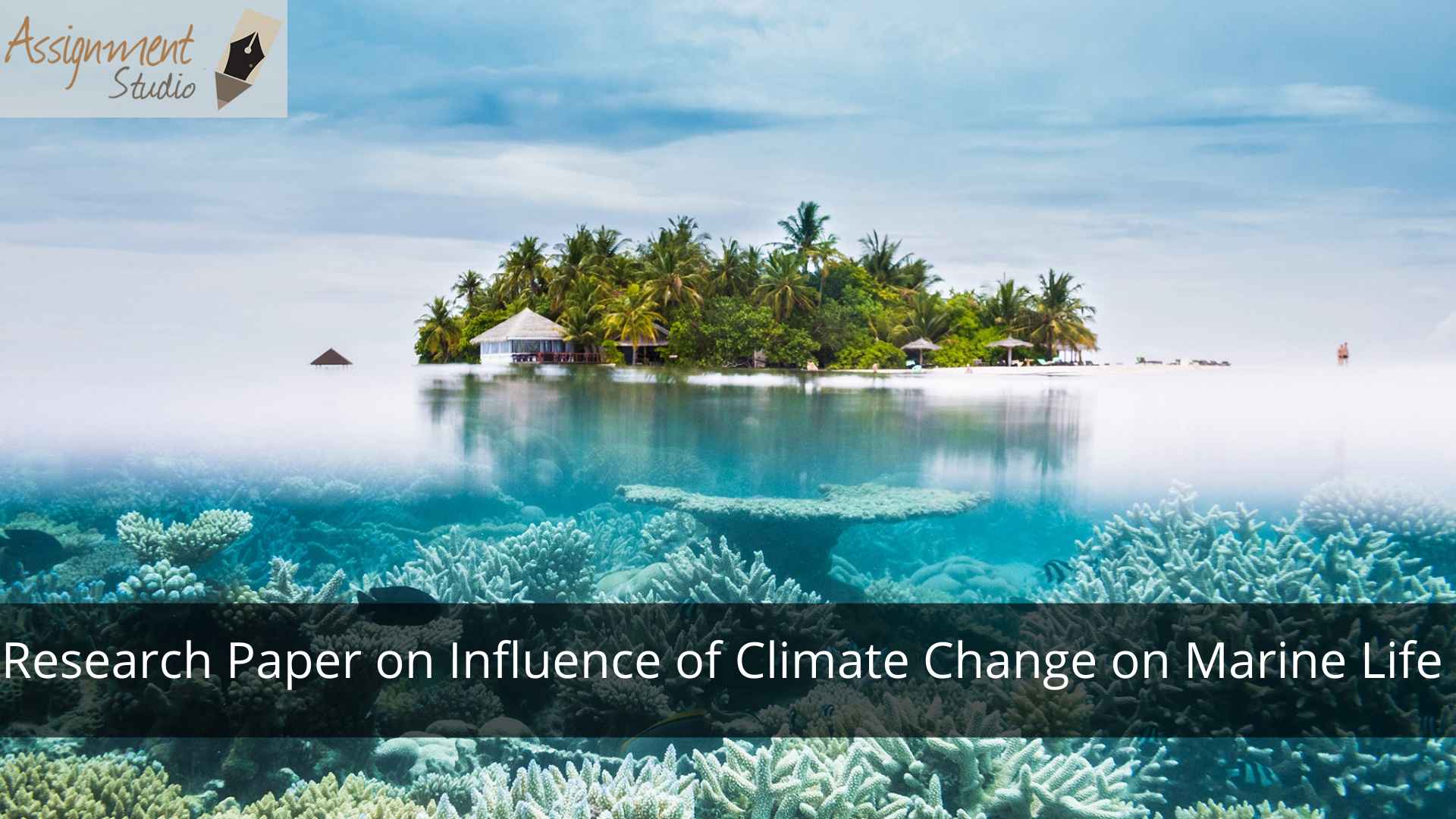Research Paper on Influence of Climate Change on Marine Life
SUMMARY
Climate change is a threat to the world today. It is one of the global issues the world is making efforts to deal with. Not only it has endangered the lives of people but also the marine life. Marine life in the oceans is an important source of oxygen for the Earth planet and it captures and takes away the carbon dioxide from the atmosphere (Dunlap, 2002). Marine life is important as it provide for medicines, food and livelihood. Marine life makes the environment suitable for tourism and recreational activities (Corbett & Durfee, 2004). Oceans are considered as lifeblood of the Earth as it provides half of the oxygen needed and takes away most of the carbon dioxide from the atmosphere.
The following research seeks to look for ways to deal with climate change issues and its influence on marine life. Global warming and climate change have posed threat to marine life such as coral reef ecosystem. The issue will be discussed in detail in the research and data from the secondary sources will be acquired and analyzed to improve the understanding of the government and policy makers. Aim of this research is to make the issue more visible among the policy practitioners so that they can make efforts to deal with the issue. The Caribbean Mitigation Plan will be utilized for the aforesaid research.
WHAT IS THE PROBLEM?
Climate change is one of the major environmental issues faced by the world today. Average temperature of Earth has been increasing since the emergence of Industrial Revolution. It is widely viewed by the scientists that the global warming is a result of increase in atmospheric gases such as Carbon dioxide (CO2), Nitrous Oxide (NO2) and Methane (CH4). Major contributors to higher levels of green house gases are burning of fossil fuels (oil, coal and gas), agricultural activities and clearing of forests (Nogaard, 2006). Higher levels of green house gases trap the levels of energy arriving on earth surface. Increasing concentration of green house gases raise the temperature of earth by trapping the heat from the sun and not allowing it from reverting back to the surface. It is estimated that Earth holds 820 terawatts of heat each year and 40 times more the absolute energy consumption.
According to Arizoy (2008), around 95% of scientists believe that causes of climate change is human-made issue. Anal (2005) asserts that it is agreed by international agreements that about 200 nations are responsible for global climate change and among those nations are Japan, Russia, Italy, Germany, Canada, the USA and the UK. However, some academics believe that climate change is not only a result of human activity. Other factors such as the solar cycle or the increase in volcanic eruptions in recent times are behind increasing global temperature.
Scientists estimate that atmosphere is changing rapidly due to heating effects of green house gases. The concentration of carbon dioxide is increasing by 7% since 2007. It is stated by IPCC that if no efforts are made in dealing with or mitigating the effects of climate change, the concentration of CO2 will increase to 1300 ppm by 22nd century (Leiserowitz, 2006). The adverse impacts of global warming are unfolding faster. It was expected by IPCC in 2007 that the global average sea level will increase by 0.6 meters in 22nd century, however the expectation was revised to 0.98 meters in 2013 and to 2 meters in 2016. Likewise, IPCC also estimated the pace of melting of Arctic ice to become ice-free Arctic in 22nd century, however the prediction was revised for it to 30 years (McCright, 2007).

Climate change and global warming is rapidly damaging the environment and posing severe impact on the living beings. According to Zahran, Brody, Grover & Vedlitz (2006), sea level is rising as high temperatures have caused the ice to melt that flows into the oceans. The sea level has risen by 0.98 meters and is expected to rise by 2 meters by year 2200. Almost two third of the largest cities are in coastal areas thus the population of 700 million living on the area are endangered and have to relocate.
Not only the rising seal level but also the changes in weather patterns and extreme weather are consequence of global warming. The higher temperature means that the atmosphere is able to hold excess vapors, allowing the greater rates of rainfall and runoff (Hersch & Viscusi, 2014). According to Brechin (2012), due to the increase in temperature, the pattern of rainfall is shifting around the world more frequently and intensively. Extreme drought is witnessed in the world since 2010, resulting in less production of food and famines in extreme weather conditions.
Food production is dependent on water availability. In 2016, just 16% of the Earth’s agricultural land was cultivated that produced only 36% of global harvest. Increases in temperature have made the world most vulnerable to erratic rainfalls and shrinking glaciers, and thus raising fear among the population for the water availability. It is expected that by 2030, the overall demand for water will increase by 40% than the supply of water. With the increasing population coupled with water shortages will make the life on earth unsustainable.
Climate change has impeded political instability in the world. Since the sharp increase in prices of food in 2007, dozens of riots caused accidental casualties in India, Haiti, Cameroon and Argentina (Dunwoody, 2007). Syrian civil war and Somalian civil war, both are linked to severe drought and famines, resulting from climate change. Increasing temperature has made the health and life of people vulnerable to stroke and death-borne diseases. Around 70000 people died in Europe due to heat stroke and 50000 in Russia (Brechin, 2012).
Global warming is a challenge that the world is facing now. According to ACNielsen (2007), there are many international agreements on dealing with the issue. Nonetheless, the issue is become grave day-by-day, leading to innumerous social, political, economic challenges. Rising temperature throughout the world is real challenge now, which needs to be mitigated.
AIMS OF THE RESEARCH
The research is aimed at providing policy makers and managers with information for understanding the impacts of climate change on coral reef ecosystem. The knowledge will help guide policy makers to the management of ecosystem resilience. Climate change is one of the global issues that are posing threat to sustainability of the world. All the marine life has become vulnerable to the deleterious impacts of climate change. Human activities are most likely the reason for increase in green house gases that result in increase of temperature on the Earth. Thus the increase in temperature and high levels of CO2 in the environment are one of the major and the greatest threat to the long-term future of coral reef in the ocean (Akaike, 2010). Global warming and climate change have disturbed the coral reef ecosystem by pushing them out of their comfort zone where they have lived for hundreds and thousands of years. In addition to other human induced and natural pressures, warming sea and ocean acidification has also resulted in coral diseases, coral bleaching, tropical cyclones and crown-of-thorns starfish (Akaike, 2010).
The aim of research is to understand the methods of mitigating the surface temperature of sea resulting in heat stress events and massive coral bleaching. Impacts of climate change resulted in increase of tropical cyclone thus not only endangering the marine life and reef structure but also the life of people living at coastal areas. Australia’s marine ecosystem is already under threat from the consequences of climate change. It is revealed that the temperature of tropical sea surface has risen by 0.5 centigrade since the nineteenth century. From the 18th century till now, the oceans have taken up about 40% of the carbon dioxide generated the human activities into the atmosphere. The increase levels of carbon dioxide in the ocean water have changed the chemistry of water, resulting in acidification of ocean and pH of water decreasing from 8.15 to 8 (Zahran, Kim, Chen & Lubell, 2007). The research aims to find out the method by which it will mitigate the levels of carbon dioxide getting absorbed in the ocean.
Marine life adapts to the ocean circulation cycle and water patterns. Increase in storms and rainfalls will disturb the cycle of oceans and marine life adaptation. It therefore endangers the living pattern of marine life. The research will try to investigate the patterns, and devise/suggest strategies on dealing with the marine life threats. Indeed, global warming is threat to social and political of the global economy. It is a threat that needs to be handled in letter and spirit.
METHODOLOGY
For the coastal region, it will first inspect the vulnerabilities to existing climate and weather variability, including storm surge scenarios and sea level rise. These comprise low- lying coastal zones affected by erosion, inundation, and saline intrusions. In order to scientifically look for a way to solve the research problem a suitable research methodology should be carried out. The impact in coral reef ecosystem will be defined using the data from secondary resources updated by Climate Change Mitigation Institution. Data for change in temperature and precipitation is appropriate to develop understanding of impacts of climate change on coral reef ecosystem. The natural water resources capacity used in hydroelectric power generation can be evaluated against projected climate change and variability. This needed the definition of the hydroelectric facilities and the water source. After this, water resource model will be utilized to replicate hydrological systems. Information of hydrological system will be accessed from meteorological department.
Navigate the complexities of climate change on our planet with Assignmentstudio. Our research illuminates the profound effects of Climate Change Drastically Affecting Our Planet, empowering individuals and organizations to take meaningful action.
Discover innovative approaches to Water Quality Management with Assignmentstudio. Our tailored services provide holistic solutions, addressing diverse challenges to ensure pristine water quality for ecosystems, industries, and communities worldwide.

Hire Expert Writers at
Affordable Price
WhatsApp
Get Assignment Help



